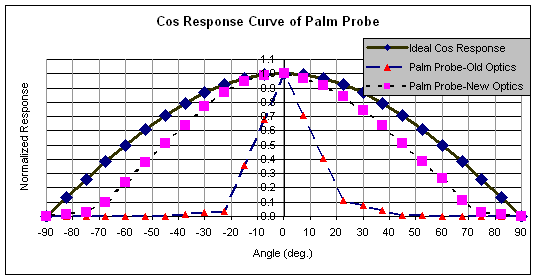Guide to UV Measurement
Angular Response - Cosine
The angular response of a radiometer is the “weighting” it gives to arriving rays, depending on the angle of incidence. When this weighting is proportional to the cosine of the angle of incidence, (0° is perpendicular to the surface), the radiometer is said to have “cosine response.” Although arbitrary, there are two reasons for a UV process radiometer to have cosine response: (1) it is an approximation of the “weighting” that occurs naturally in the curing of a film, and (2) it is geometrically defined and reproducible.
In near-field linear processing (flat curing), the majority of the UV flux is nearly perpendicular to the surface and, in both axes of a tubular lamp, diminishes to nearly zero at ±45°. Consequently any deviation from cosine response causes only small errors. But, in 3-D processing, complex surfaces are not uniformly situated perpendicularly to the source, and any part of the surface may be oriented so that the only flux it receives arrives at an oblique angle, so serious cosine deviation can result in measurement error.
Some instruments are specialized or have unique optics designs that do not permit simulation of a cosine response.
Instrument manufacturers often have to test different optical components or ‘stacks' when designing a new instrument. The ideal cosine response is blue below and you can see the early cosine response for a new probe style instrument and a cosine response from later combinations of materials.
